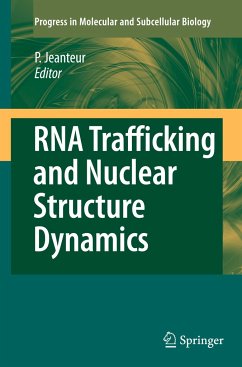
The Golgi Network, Volume I
Golgi Organization and Dynamics
Herausgegeben: Nakano, Akihiko; Saraste, Jaakko

PAYBACK Punkte
76 °P sammeln!
The Golgi apparatus was discovered by Camillo Golgi in 1898. Today, more than 125 years later, the Golgi apparatus is still a key object of active biochemical and cell biological research. The role of this organelle as a glycosylation factory has been well recognized while its function as a central station in protein sorting in membrane trafficking has raised many disputes during the past decades.Morphologically, the beautiful cisternal stacks are often considered a typical structure of the Golgi, but looking across a variety of eukaryotic species, large variations in Golgi organization become...
The Golgi apparatus was discovered by Camillo Golgi in 1898. Today, more than 125 years later, the Golgi apparatus is still a key object of active biochemical and cell biological research. The role of this organelle as a glycosylation factory has been well recognized while its function as a central station in protein sorting in membrane trafficking has raised many disputes during the past decades.
Morphologically, the beautiful cisternal stacks are often considered a typical structure of the Golgi, but looking across a variety of eukaryotic species, large variations in Golgi organization become apparent. Despite the long history of Golgi research, there still are many unanswered questions. How are Golgi residents and passing cargo proteins and lipids sorted from each other and find their correct transport routes and final destinations? What are the carriers or mechanisms mediating communication between cisternae vesicles, tubules, or close membrane contacts? How is the compositional polarity of the organelle between the cis- and trans-sides established and maintained? What are the contributions of lipids in Golgi organization and function? Why do the cisternal Golgi stacks form ribbon structures in vertebrates? What are the precise roles of next-door neighbors of the Golgi the intermediate compartment (ERGIC/IC) at the cis-face and the trans-Golgi network (TGN) at the trans-face in its maintenance and function? To address these questions, many new technologies have been developed, leading to exciting discoveries. For example, state-of-the-art microscopic methods, such as high-speed and high-resolution live imaging and correlative light and electron microscopy are regarded as very promising approaches and are therefore undergoing continuous development.
This first volume of two presents the latest knowledge about the Golgi Organization and Dynamics covering different kingdoms from Fungi to Animals, put together by leading experts inthe field contributing individual chapters to this book, which represents an exceptional collection of current concepts about the Golgi and its neighboring organelles. As such it is a valuable resource for both researchers and students.
Morphologically, the beautiful cisternal stacks are often considered a typical structure of the Golgi, but looking across a variety of eukaryotic species, large variations in Golgi organization become apparent. Despite the long history of Golgi research, there still are many unanswered questions. How are Golgi residents and passing cargo proteins and lipids sorted from each other and find their correct transport routes and final destinations? What are the carriers or mechanisms mediating communication between cisternae vesicles, tubules, or close membrane contacts? How is the compositional polarity of the organelle between the cis- and trans-sides established and maintained? What are the contributions of lipids in Golgi organization and function? Why do the cisternal Golgi stacks form ribbon structures in vertebrates? What are the precise roles of next-door neighbors of the Golgi the intermediate compartment (ERGIC/IC) at the cis-face and the trans-Golgi network (TGN) at the trans-face in its maintenance and function? To address these questions, many new technologies have been developed, leading to exciting discoveries. For example, state-of-the-art microscopic methods, such as high-speed and high-resolution live imaging and correlative light and electron microscopy are regarded as very promising approaches and are therefore undergoing continuous development.
This first volume of two presents the latest knowledge about the Golgi Organization and Dynamics covering different kingdoms from Fungi to Animals, put together by leading experts inthe field contributing individual chapters to this book, which represents an exceptional collection of current concepts about the Golgi and its neighboring organelles. As such it is a valuable resource for both researchers and students.












